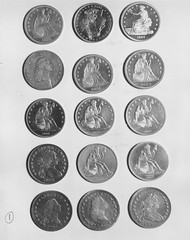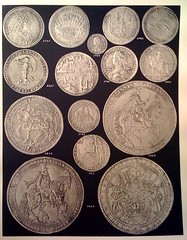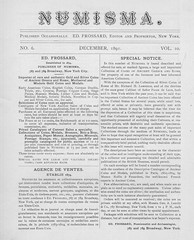
PREV ARTICLE
NEXT ARTICLE
FULL ISSUE
PREV FULL ISSUE
SELECTED LOTS FROM THE JUNE 4, 2009 FANNING NUMISMATIC LITERATURE SALE A few lots caught my eye in the upcoming Fanning Numismatic Literature sale. Dave kindly provided the text of the lot descriptions - here are some excerpts. -Editor Lot 223 . [Newcomer, Waldo]. Archive of photographs and photographic negatives depicting important U.S. gold and silver coins and private and territorial gold pieces from the Waldo Newcomer collection. The Waldo Newcomer collection was one of the finest of its day, and remains an important achievement in the history of coin collecting in the U.S. In some areas (such as private and territorial gold), it was magnificent. Unfortunately, it is also one of the most important collections of U.S. coins ever assembled for which a full catalogue was never written. No auction sale was held, no sylloge compiled: meaning that for provenance studies, the Newcomer collection is something of a black hole, with little certain information about what exactly it contained (Morgenthau and Mehl did sell some of Newcomers duplicates and world coins).   The main collection was liquidated through B. Max Mehl, who sold many of the pieces directly to Col. E.H.R. Green (hence the writing on some of these envelopes identifying the photos as being of his coins). The photographs and negatives offered here were taken for Mehl, with some bearing Ft. Worth photographer stamps. While there have been offerings of photographs from the Newcomer collection on a couple occasions (in George Kolbe’s 1993 ANA sale and in Part II of the Champa library sales catalogued by Charles Davis, earlier in a March 1993 Money Tree sale), this may be the first time that actual photographic negatives depicting the collection have been publically offered. These were part of the B. Max Mehl estate, and were subsequently acquired by Abe Kosoff. Lot 397 Chapman, Henry. Catalogue of the John Story Jenks Collection of Coins. Ancient, Greek, Roman and the Entire World. Early American Colonial and State Issues and United States Patterns and the Regular Issues. Philadelphia, Davis & Harvey, Dec. 7–17, 1921. Arguably the most important American cabinet ever sold, in terms of both total coverage and quality. While other collections have been formed that exceeded the Jenks cabinet in depth, few if any rival it in breadth while maintaining a focus on outstanding condition. Were the sale to have included only the U.S. material, it would have been an excellent sale, with exquisite early coppers, important patterns, rare private and territorial gold, and other desiderata. Indeed, most of the highest prices were from this part of the sale. Yet, the coins of the Western Hemisphere don’t even start until lot 5315. The first several thousand lots constitute a veritable atlas of numismatics. A decadrachm of Syracuse signed by Kimon is included, as is Simon’s Petition Crown of 1663. The 42 photographic plates illustrate an incredible 1,412 lots. In addition to the catalogue’s unquestionable importance is its rarity: John W. Adams noted that “Most of the [Chapman] quarto plate editions were printed in runs of 100. Two exceptions are Siedlecki (1911) and Jenks (1921) of which only fifty and sixty were made respectively.” Most surviving copies are well worn, due partly to the catalogue’s massive size and due partly to its being the best single-volume reference to the coins of the world for probably half a century or more. Lot 316 Frossard, Ed. Numisma. Group of 9 numbers [as published in 8 issues] plus one supplement.  A nice group of later issues of the house organ which provides much of the basis for Frossard’s lasting reputation. Modest in appearance, with the average issue being only eight pages long, Numisma is one of the most entertaining publications ever to grace the hobby: by parts scholarly and serious, it was also back-stabbing, venomous and filled to the brim with gossip of every description, making it as much fun to read 120 years later as it must have been on its original publication (if one wasn’t on the receiving end of Frossard’s stings). A nice group of later issues of the house organ which provides much of the basis for Frossard’s lasting reputation. Modest in appearance, with the average issue being only eight pages long, Numisma is one of the most entertaining publications ever to grace the hobby: by parts scholarly and serious, it was also back-stabbing, venomous and filled to the brim with gossip of every description, making it as much fun to read 120 years later as it must have been on its original publication (if one wasn’t on the receiving end of Frossard’s stings). What was standard journalistic fare to Frossard would probably land a publisher in court today. Part house organ, part unofficial supplement to the American Journal of Numismatics, part scandal sheet and yellow journalism, Numisma played a role in the hobby of the late 19th century that could not be compared to that of any publication today. Wayne Homren, Editor The Numismatic Bibliomania Society is a non-profit organization promoting numismatic literature. See our web site at coinbooks.org. To submit items for publication in The E-Sylum, write to the Editor at this address: whomren@gmail.com To subscribe go to: https://my.binhost.com/lists/listinfo/esylum All Rights Reserved. NBS Home Page Contact the NBS webmaster 
|